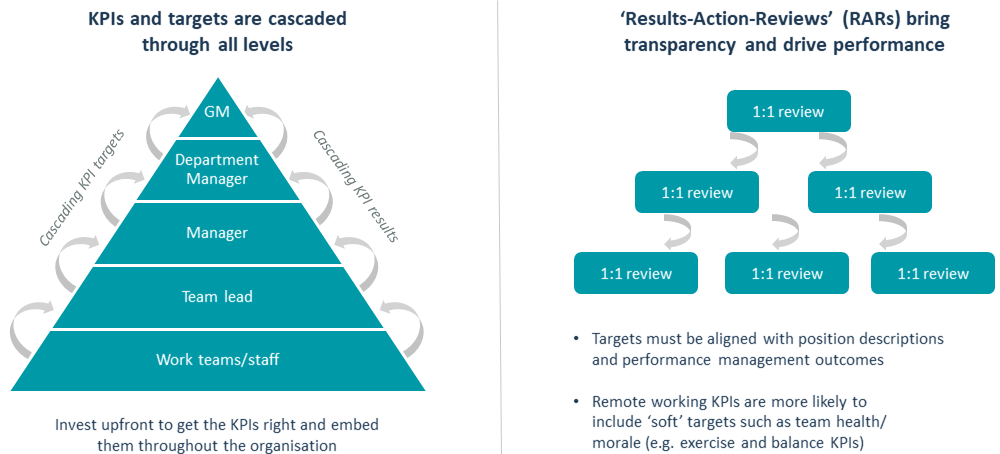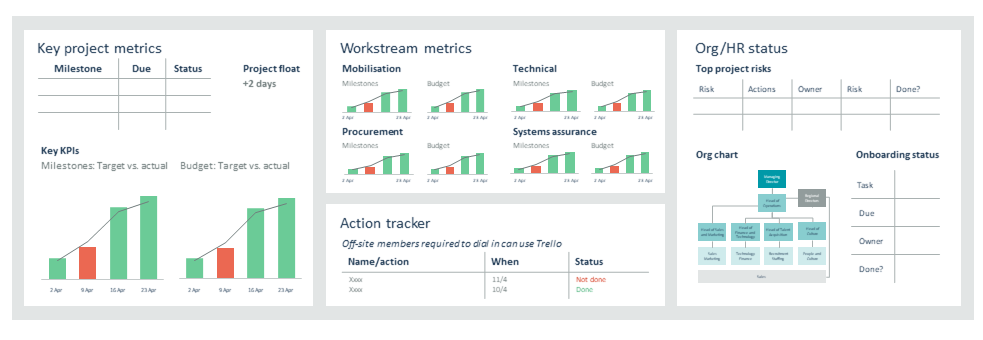No time? Grab the information and go
Here's what you need to know in short:
1. Keep your teams and organisation safe
2. Be explicit about what is required – what, when and whom
3. Understand your remote team – everyone works differently
4. Leverage digital platforms
5. Set your remote team norms to maintain collaboration and connection
6. Chat more often – emails aren’t enough
7. Recognise that clients and suppliers are dealing with the same challenges
For some, remote working has been a valuable working solution for several years. However, it didn’t just occur overnight, and, for many, it was possible because they could depend on a co-located office-based team in the background. Entire organisations working remotely alongside more seasoned remote workers is an uncharted territory which requires effective leadership. While keeping your company performing remotely is important to deliver your strategy, it also helps the teams within it feel valued and valuable. And, if you can get them working well remotely, they will be more efficient, more together and more adaptable when – or if – they return to the office.
In normal circumstances, we find six elements are crucial to making remote working work, while the current realities add a seventh factor:
1. Keep your teams and organisation safe
2. Be explicit about what is required – what, when and whom
3. Understand your remote team – everyone works differently
4. Leverage digital platforms
5. Set your remote team norms to maintain collaboration and connection
6. Chat more often – emails aren’t enough
7. Recognise that clients and suppliers are dealing with the same challenges
1. Keep your teams and organisation safe

With your teams working remotely, there is no visibility of their working conditions and possible risks. The lucky few will work in an established home office, but many will be working from the kitchen table or the bedroom, bringing new challenges and stiff necks.
It is important to help your team think through how to reduce obvious risks (e.g. raise laptops where possible), as well as identifying and addressing other unexpected risks.
And, with many people working remotely for the first time, their mental health may be affected. Most organisations have Employee Assistance Programmes – now is the time to remind your team that they exist and encourage them to access them when needed.
If some teams have limited work in the short term (e.g. recruiting), consider how you might mobilise them, and call your people individually to check how they are coping. More informal forums (e.g. WhatsApp) among cohorts or teams can also help to maintain a sense of community, whether this is swapping jokes or asking for help with a problem.
At an organisational level, revisit safety programmes and risk frameworks to ensure they cover the challenges of working remotely. This may mean developing new protocols and providing alternative equipment to your remote team to keep them fit, healthy and sane.
Some questions to ask your organisation:
- Has every person working remotely completed a risk assessment with appropriate mitigation plans?
- What happens if an employee hurts themselves while working outside the office?
- Does our risk framework cover remote working arrangements? How is it monitored and evaluated?
- Are individuals aware of your Employee Assistance Programme and know how to access it?
2. Be explicit about what is required – what, when and whom
Remote working at its worst allows inefficiencies, duplicates effort, fosters uncertainty and delays, and causes low morale. Organisations can be slower to spot these issues as they arise because colleagues are unable to meet. In parallel, new ways of teamworking will emerge spontaneously and independently, driving both good and poor practice.
To address this, it is important to set clear expectations:
- Agree priority deliverables for the time period (week, month, quarter)
- Agree specific actions to deliver these priorities
- What needs to be done
- When is it needed by
- Which one person is accountable to deliver it - Overinvest in transparency and visibility of comms
- Ensure all stakeholders are in the loop upfront to avoid duplication of efforts
- Celebrate great examples of coordination across the organisation, while also sharing lessons learned - Document key processes and protocols as you go
- Document processes and protocols designed for or evolving in the home-working environment
- Make them widely available to those who need them - Overinvest in time chatting to your people and checking they are OK, both physically and mentally
We consistently apply this to achieve clear accountability with supporting targets, cascading through the organisation, to enable all members of a highly dispersed workforce to pull in the same direction.
 Some questions to ask your organisation:
Some questions to ask your organisation:
- Do all team members understand what is expected of them?
- Are regular reviews occurring to check status, agree priorities and determine next steps?
- Are key processes documented and readily available to those who need them?
3. Understand your remote, home-based team (including your own preferences)
Everyone works differently in the office and that’s equally true when working remotely, although an individual’s personal situation may complicate remote work further.
- Recognise individual working styles: Some will find it a welcome relief to work at home alone, others will miss the energy of having people around, while some despair at being unable to draw a clear line between home and work. Each leader needs to understand what their people need so they can work at their best.
- Invest the time to listen, care and understand what they’re going through: From a distance, you cannot be sure whether it’s a bad day or a structural or personal issue when working remotely.
- Assume positive intentions and encourage others to do so: Give people the benefit of doubt, especially during difficult periods, yet recognise it may be necessary to intervene quickly to address situations before they escalate.
- Don’t underestimate the importance of taking care of yourself: Irrespective of your seniority, some form of down-time and distraction is critical. Chances are this is a marathon, not a sprint, so taking care of yourself and leading by example is vital.
Some questions to ask your organisation:
- Is there flexibility to adapt working hours or meeting times?
- How are your team adjusting? How can you help them through the process?
4. Leverage digital platforms
Email will only get you so far. Digital platforms offer far more potential than most organisations currently use.
While your established technology architecture will continue to function, some people may not have what they need to perform their roles outside the office, whether this is tools like smart phones or laptops, or access to the internet.
Working remotely introduces additional challenges around data and security, so it’s important to engage IT early in the process of finding an appropriate, sustainable solution. They play a crucial role, as existing processes and policies often limit how quickly a team can access systems from outside the office.
Home networks are typically not as secure as corporate networks, particularly when networks are shared (e.g. multiple people working from home, children distance learning), so your organisation's 'human firewall' becomes more important to protect your organisation from cyber threats.
Once the basics are in place, there is a vast array of online platforms available to enable communication (e.g. Skype, WhatsApp), information sharing and collaboration (e.g. Google Docs, Miro, Microsoft Teams) and project management (e.g. Trello, Monday.com, BaseCamp), as well as governance (e.g. Diligent, Boardvantage). This is an ideal opportunity to see how they will work within your organisation.
An effective dashboard means the team can track key metrics, status and actions in one place
If this is the first time using these platforms, help people familiarise themselves with how to use them. This could include training, either in groups or self-guided, or appointing ‘ambassadors’ to provide support within divisions or regions. With practice, these platforms will become just another part of your organisation’s toolkit and culture, enabling greater coordination and contribution.
Experiment with a note of caution – don’t rely on any single digital tool for every aspect of communication and collaboration, as they’re not designed to do everything. There is no one-size-fits-all, so each team will need to figure out what works for them. And, not all collaboration tools play nicely together, so your IT or cyber teams should have a holistic view of the tools being used to identify hidden cyber risks.

Some questions to ask your organisation:
- Does everyone in your organisation have the required tools and infrastructure to work remotely and collaboratively?
- How is adoption of new tools being supported and encouraged?
- Is IT actively involved and engaged in rolling out new digital platforms?
- Have cyber risks been assessed and mitigated?
5. Set your remote team norms
Freshly remote teams need to get their new norms explicitly set-up and embedded early – this should include regular catch ups to share progress, solve problems and communicate on specific topics, rather than drowning in a sea of emails. Set your remote team norms to maintain optimal collaboration and connection:
- Take the lead in locking in frequent communication
- Assign central accountability for sharing and reinforcing team best practice
- Surface preferences and let people find their ideal level within reason - Exploit tools available to keep it casual and minimise adaptation required
- Video call and screenshare to see people during team calls
- Virtual group chats act as informal forums – exploit the tools colleagues already use
Note that as a leader, you are likely to communicate more than you normally do for a while, and it’s critical you maintain enough energy to facilitate your role.
Some questions to ask your organisation:
- Have all teams established regular ‘meetings’ to catch up as a group?
- Are your team aware of available tools to stay connected personally?
- Do your teams know where to find relevant information and support?
6. Chat more often
Leaders can no longer see their team and vice versa, so the natural cues that come from actions, guidance and coaching in the office disappear. This can be achieved with remote teams; it just needs a different approach.
While emails will significantly increase, most successful remote working managers do not rely on these – instead they call often, holding daily calls – by phone, Skype Video, FaceTime or WhatsApp – with teams, sub-sets of teams, and individuals to check in.
Some questions to ask your organisation:
- Do all teams have regular meetings set up, either as voice or video calls?
- When did you last pick up the phone?
7. Support your clients, contacts and suppliers who are dealing with the same challenges
Every business is dealing with their own challenges and some will shift more rapidly to remote work than others. Encourage your organisation to show empathy where possible – you can support your customers and suppliers by being understanding and, if opportunity allows, sharing your experience of what has worked and what hasn’t.
Some questions to ask your organisation:
- Are our key suppliers and customers are working remotely?
- Have we spoken to them to understand how working remotely might affect their offering?
Conclusion
By applying these tips and tricks, we’ve built an effective and happy remote team which both performs and values individuals. We hope they provide some useful pointers to help your organisation, as we all navigate the challenge of operating remotely.
About the authors

Guy Turner
Director and Global Capital Practice Lead
Guy leads our Global Capital Practice. He brings over 20 years’ experience in delivering capital and construction projects and is familiar with the challenges of working remotely – he assists clients around the globe, while building the Capital Practice with our team across North America, Europe, the Middle East and Australasia.

Phil Weinberg
Global Intellectual Property, Capability and Remote Support lead
Phil builds and nurtures our capability and intellectual property teams from somewhere near Reading in the UK. He has participated in many late night and early morning phone calls with team members across four continents to support our global team.

